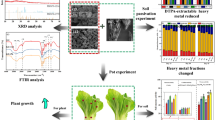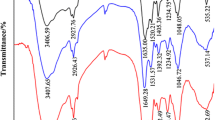Abstract
Harmful algal bloom has posed great threat to drinking water safety worldwide. In this study, soils were combined with commercial nontoxic polyamine poly(epichlorohydrin–dimethylamine) (PN) and polymeric ferric sulfate (PFS) to obtain PN-PFS soils for Microcystis removal and eutrophic water remediation under static laboratory conditions. High pH and temperature in water could enhance the function of PN-PFS soil. Algal removal efficiency increased as soil particle size decreased or modified soil dose increased. Other pollutants or chemicals (such as C, P, and organic matter) in eutrophic water could participate and promote algal removal by PN-PFS soil; these pollutants were also flocculated. During PN-PFS soil application in blooming field samples, the removal efficiency of blooming Microcystis cells exceeded 99 %, the cyanotoxin microcystins reduced by 57 %. Water parameters (as TP, TN, SS, and SPC) decreased by about 90 %. CODMn, PO4-P, and NH4-N also sharply decreased by >45 %. DO and ORP in water improved. Netting and bridging effects through electrostatic attraction and complexation reaction could be the two key mechanisms of Microcystis flocculation and pollutant purification. Considering the low cost of PN-PFS soil and its nontoxic effect on the environment, we proposed that this soil combination could be applied to remove cyanobacterial bloom and remediate eutrophic water in fields.










Similar content being viewed by others
References
Acuña S, Baxa D, Teh S (2012) Sublethal dietary effects of microcystin producing Microcystis on threadfin shad, Dorosoma petenense. Toxicon 60(6):1191–1202
AWWARF (1987) Current methodlogy for the control of algae in surface waters. Research report. AWWA, Denvor
Bautista J, Jover M, Gutierrez JF, Corpas R, Cremades O, Fontiveros E, Iglesias F, Vega J (2001) Preparation of crayfish chitin by in situ lactic acid production. Process Biochem 37(3):229–234
Chen X-C, Kong H-N, He S-B, Wu D-Y, Li C-J, Huang X-C (2009a) Reducing harmful algae in raw water by light-shading. Process Biochem 44(3):357–360
Chen X, He S, Huang Y, Kong H, Lin Y, Li C, Zeng G (2009b) Laboratory investigation of reducing two algae from eutrophic water treated with light-shading plus aeration. Chemosphere 76(9):1303–1307
Chen J, Zhang H, Han Z, Ye J, Liu Z (2012) The influence of aquatic macrophytes on Microcystis aeruginosa growth. Ecol Eng 42:130–133
Chorus I, Bartram J (1999) Toxic cyanobacteria in water: a guide to their public health consequences, monitoring and management. Spon Press, London
Dai GF, Quan CY, Zhang XZ, Liu J, Song LR, Gan NQ (2012) Fast removal of cyanobacterial toxin microcystin-LR by a low-cytotoxic microgel-Fe(III) complex. Water Res 46(5):1482–1489
Edzwald JK, Tobiason JE (1999) Enhanced coagulation: US requirements and a broader view. Water Sci Technol 40(9):63–70
Entry JA, Phillips I, Stratton H, Sojka RE (2003) Polyacrylamide+Al2(SO4)3 and polyacrylamide+CaO remove coliform bacteria and nutrients from swine wastewater. Environ Pollut 121(3):453–462
Fuentes M, Olaetxea M, Baigorri R, Zamarreño AM, Etienne P, Laîné P, Ourry A, Yvin J-C, Garcia-Mina JM (2013) Main binding sites involved in Fe(III) and Cu(II) complexation in humic-based structures. J Geochem Explor 129:14–17
Gan N, Xiao Y, Zhu L, Wu Z, Liu J, Hu C, Song L (2012) The role of microcystins in maintaining colonies of bloom-forming Microcystis spp. Environ Microbiol 14(3):730–742
Hadjoudja S, Deluchat V, Baudu M (2011) Cell surface characterisation of Microcystis aeruginosa and Chlorella vulgaris. J Colloid Interface Sci 342(2):293–299
Hao B, Wu H, Shi Q, Liu G, Xing W (2013) Facilitation and competition among foundation species of submerged macrophytes threatened by severe eutrophication and implications for restoration. Ecol Eng 60:76–80
Hu CL, Gan NQ, He ZK, Song LR (2008) A novel chemiluminescent immunoassay for microcystin (MC) detection based on gold nanoparticles label and its application to MC analysis in aquatic environmental samples. Int J Environ Anal Chem 88(4):267–277
Greger M, Johansson M (2004) Aggregation effects due to aluminum adsorption to cell walls of the unicellular green alga Scenedesmus obtusiusculus. Phycol Res 52(1):53–58
Joo DJ, Shin WS, Kim Y-H, Kim JH, Choi JH, Choi SJ, Park L-S (2003) Effect of polyamine flocculant types on dye wastewater treatment. Sep Sci Technol 38(3):661–678
Lawton LA, Robertson PKJ, Cornish B, Marr IL, Jaspars M (2003) Processes influencing surface interaction and photocatalytic destruction of microcystins on titanium dioxide photocatalysts. J Catal 213(1):109–113
Li L, Pan G (2013) A universal method for flocculating harmful algal blooms in marine and fresh waters using modified sand. Environ Sci Technol 47(9):4555–4562
Li Q, Su Y, Yue Q-Y, Gao B-Y (2011) Adsorption of acid dyes onto bentonite modified with polycations: kinetics study and process design to minimize the contact time. Appl Clay Sci 53(4):760–765
Liu YM, Chen W, Li DH, Huang ZB, Shen YW, Liu YD (2011) Cyanobacteria-/cyanotoxin-contaminations and eutrophication status before Wuxi Drinking Water Crisis in Lake Taihu, China. J Environ Sci China 23(4):575–581
Maske SS, Sangolkar LN, Chakrabarti T (2010) Temporal variation in density and diversity of cyanobacteria and cyanotoxins in lakes at Nagpur (Maharashtra State), India. Environ Monit Assess 169(1–4):299–308
McKnight D, Chisholm S, Harleman DF (1983) CuSO4 treatment of nuisance algal blooms in drinking water reservoirs. Environ Manag 7(4):311–320
Pan G, Zou H, Chen H, Yuan XZ (2006) Removal of harmful cyanobacterial blooms in Taihu Lake using local soils. III. Factors affecting the removal efficiency and an in situ field experiment using chitosan-modified local soils. Environ Pollut 141(2):206–212
Pan G, Dai L, Li L, He L, Li H, Bi L, Gulati RD (2012) Reducing the recruitment of sedimented algae and nutrient release into the overlying water using modified soil/sand flocculation-capping in eutrophic lakes. Environ Sci Technol 46(9):5077–5084
Ross C, Santiago-Vázquez L, Paul V (2006) Toxin release in response to oxidative stress and programmed cell death in the cyanobacterium Microcystis aeruginosa. Aquat Toxicol 78(1):66–73
Sathishkumar M, Pavagadhi S, Vijayaraghavan K, Balasubramanian R, Ong SL (2010) Experimental studies on removal of microcystin-LR by peat. J Hazard Mater 184(1–3):417–424
Sevilla E, Martin-Luna B, Vela L, Bes MT, Fillat MF, Peleato ML (2008) Iron availability affects mcyD expression and microcystin-LR synthesis in Microcystis aeruginosa PCC7806. Environ Microbiol 10(10):2476–2483
Shang HZ, Zheng YB (2009) Composition of P(AM-DMC-MPMS)/PFS and its application in decolorization. Mod Chem Ind (in chinese) 29(10):47–50
Sim TS, Goh A, Becker EW (1988) Comparison of centrifugation, dissolved air flotation and drum filtration techniques for harvesting sewage-grown algae. Biomass 16(1):51–62
Singh S, Pradhan S, Rai LC (1998) Comparative assessment of Fe3+ and Cu2+ biosorption by field and laboratory-grown Microcystis. Process Biochem 33(5):495–504
Wang DS, Liu HL, Yan MQ, Yu, JF, Tang HX (2006) Enhanced coagulation VS.optimized coagulation: a critical review. Acta Scientiae Circumstantiae(in chinese) 26(4):544–551
Wu X, Kong F, Chen Y, Qian X, Zhang L, Yu Y, Zhang M, Xing P (2010) Horizontal distribution and transport processes of bloom-forming Microcystis in a large shallow lake (Taihu, China). Limnologica Ecol Manag Inland Waters 40(1):8–15
Xu Q, Chen W, Gao G (2008) Seasonal variations in microcystin concentrations in Lake Taihu, China. Environ Monit Assess 145(1–3):75–79
Xu H, Zhu G, Qin B, Paerl HW (2013) Growth response of Microcystis spp. to iron enrichment in different regions of Lake Taihu, China. Hydrobiologia 700(1):187–202
Xue H-B, Stumm W, Sigg L (1988) The binding of heavy metals to algal surfaces. Water Res 22(7):917–926
Zhang K, Lin TF, Zhang T, Li C, Gao N (2013) Characterization of typical taste and odor compounds formed by Microcystis aeruginosa. J Environ Sci 25(8):1539–1548
Zou H, Pan G, Chen H, Yuan XZ (2006) Removal of cyanobacterial blooms in Taihu Lake using local soils. II. Effective removal of Microcystis aeruginosa using local soils and sediments modified by chitosan. Environ Pollut 141(2):201–205
Acknowledgments
This work was supported by the National Natural Science Foundation of China (Grant No. 31400405), the National Postdoctoral Foundation of China (Grant No. 2014 M561875), and the Water Science and Technology Fund (Grant No. KT201307). We thank Dr. Zhang Xianzheng and Dr. Zhang Xiaojin for their kind help in the characterization of the materials.
Author information
Authors and Affiliations
Corresponding authors
Additional information
Responsible editor: Philippe Garrigues
Electronic supplementary material
Below is the link to the electronic supplementary material.
ESM 1
(DOCX 761 kb)
Rights and permissions
About this article
Cite this article
Dai, G., Zhong, J., Song, L. et al. Harmful algal bloom removal and eutrophic water remediation by commercial nontoxic polyamine-co-polymeric ferric sulfate-modified soils. Environ Sci Pollut Res 22, 10636–10646 (2015). https://doi.org/10.1007/s11356-015-4274-4
Received:
Accepted:
Published:
Issue Date:
DOI: https://doi.org/10.1007/s11356-015-4274-4




